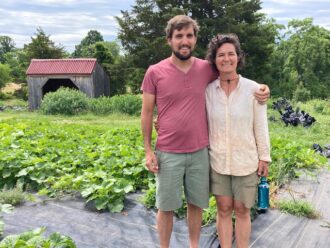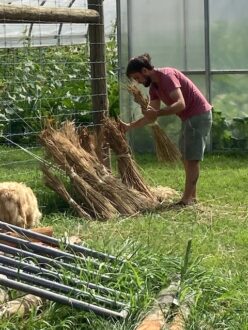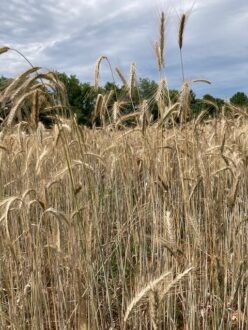FOREST, Virginia – Virginia farmer Michael Grantz is testing what it takes to incorporate cereal grains into a small-scale, diversified vegetable and cut flower farm for soil health as a cover crop and a value-added product for local markets.
Grantz has managed a quarter acre plot of wheat and rye on he and his wife’s Great Day Gardens Farm to produce bread as a value-added product at the local farmers’ market. He’s successfully yielded 100 pounds of wheat and 20 pounds of rye, but Grantz wanted to see what it would take to rotate cereal crops with mixed vegetables to create a profitable diversified enterprise for farmers with very small acreage (up to 5 acres).
Through a Sustainable Agriculture Research and Education (SSARE) Producer Grant, Grantz has scaled up wheat and rye production to 1 acre and then plans to develop enterprise budgets to calculate what the local market will bear while recording labor and expenses incurred in the growing, harvesting, processing and marketing of the grains.
“Creating a high-value, direct-to-consumer market of small, diversified farms selling flours, breads and other valued-added products has the potential to broadly impact small farm profitability for the better,” said Grantz. “Whether these grains can be grown and sold profitably at such a small scale is still in question, but we plan to use this research project to at least determine the bare minimum price at which a farmer under 5 acres can sell his/her grain and make a profit.”


Grantz said his harvest target is 1,000 pounds of Turkey red, an heirloom wheat variety common in his area, and 1,100 pounds of rye. “We think 1 acre plantings are large enough to give significant results, yet small enough to manage our farm,” he said.
But Grantz anticipates hurdling a number of challenges, such as production timing, irrigation, and equipment and labor needs.
“The timing of planting the cereal grains around the vegetable rotation is one challenge. Harvesting is perhaps the trickiest step for small producers. Cover crop plots on small-scale farms are not often scaled appropriately for a full-size combine,” said Grantz, who cuts his grain by hand (a more laborious and time-consuming method) and threshes it with a threshing machine that he’s borrowed from another farmer. “While many farms may already have access to the soil preparation, planting equipment and fertilizers needed to grow a cereal crop, the harvesting and processing steps require more specialized equipment. Small farms may need to combine capital and share equipment.”
Grantz hopes that finding a profitable way to produce, harvest and process small-scale cereal grains would not only impart more benefits to the farm, such as improving soil health, but also boost the sustainability of smaller farms by diversifying their operations with an already familiar, but high-demand product.
--30—
Great Day Gardens, located in Forest, VA is owned and operated by Michael Grantz and his wife Arden Jones. The couple produces a wide variety of mixed vegetables and cut flowers, as well as baked goods, sold through a CSA and local markets.
View Related SARE Grant:
- Small Grains on Very Small Farms (FS22-340)
